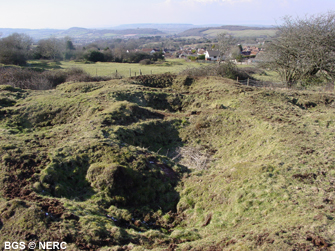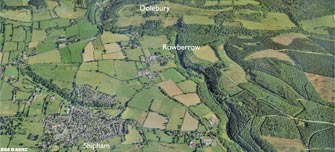
Shipham and Rowberrow
Nestling in the eroded core of the Blackdown pericline, Shipham and the neighbouring hamlet of Rowberrow were once the centre of the zinc mining industry on Mendip. Both villages are underlain by the Triassic Dolomitic Conglomerate, which overlies the Devonian sandstones of the Portishead Formation.
Mining industry
The discovery of zinc ore in the 16th century turned the small settlement at Shipham, noted in the Domesday Book, into a major mining centre. Calamine and smithsonite, along with some galena occur in veins in the Triassic Dolomitic Conglomerate. The veins mostly lay close to the surface and were worked in numerous small mines and pits, some of which are still accessible to cavers. They were generally only 30–40 m deep and were usually worked by hand with only the aid of a hand-turned windlass and a bucket. Areas of gruffy ground, a local name for the hummocky ground formed by the remains of old mine workings and waste can still be seen south of the village.

Many people living in Shipham were reliant on mining for income and life could be tough and squalid. The miners of Shipham were notorious for being rough, and it was reported that no constable would arrest them for fear of disappearing down one of the many mine shafts.
Hannah More, the well-known philanthropic writer, was appalled by the poverty in the area, and in 1790, with the help of William Wilberforce, the well-known social reformer, was instrumental in setting up both a Sunday school and a day school, as well as the first of the 'female clubs' on Mendip.
The legacy of mining also remains in the form of heavy metal contamination of the soil. Shipham has the highest levels of cadmium in the soil anywhere in the UK. Cadmium is a toxic metal associated with old zinc mine workings. However, a study found that the cadmium in the soil is tightly bound up in minerals, and is not readily available for uptake by plants. It therefore does not enter the food chain and has no measurable effect on health.
- Home
- Overview maps
- Locality
areas
- Cheddar Gorge
- Charterhouse
- Blackdown
- Burrington Combe
- Shipham & Rowberrow
- Crook Peak & Axbridge
- Banwell to Churchill
- Priddy
- Harptree & Smitham Hill
- Draycott & Westbury-sub-Mendip
- Wookey Hole & Ebbor Gorge
- Wells
- Great Elm & Vallis Vale
- Mells & the Wadbury Valley
- The Vobster area
- The Whatley area
- Torr Works & Asham Wood
- Beacon Hill
- Stoke St Michael & Oakhill
- Holwell & Nunney
- Shepton Mallet & Maesbury
- Gurney Slade & Emborough
- The Nettlebridge valley
- Geology
- Minerals and mines
- Quarrying
- Caves and karst
- Biodiversity
- Detailed site information
- Acknowledgements
- External links
- Search
- Site map
